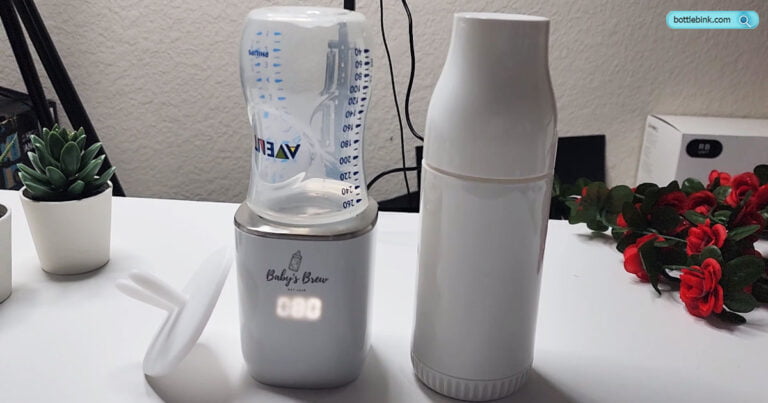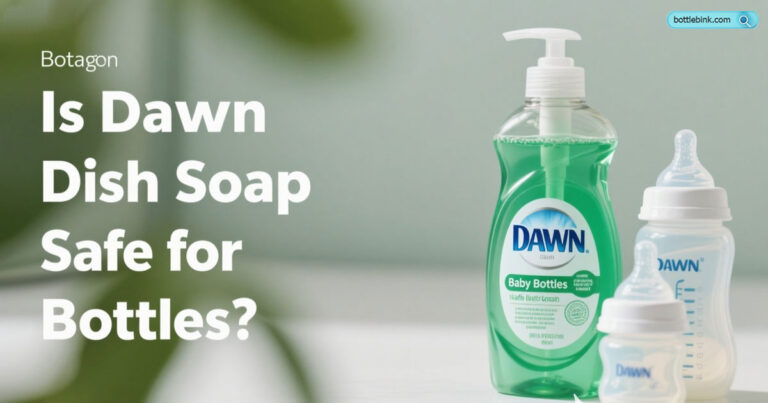Why is My Baby Refusing a Bottle? Proven Tips to Solve It Fast
Is your baby refusing a bottle, leaving you worried and unsure what to do next? You’re not alone.
Many parents face this challenge, and it can feel frustrating and confusing. Understanding why your little one is turning away from the bottle can make all the difference. You’ll discover simple reasons behind this behavior and easy tips to help your baby feel comfortable and happy with feeding again.
Keep reading—you’re just a few steps away from easing mealtime stress and making feeding time smoother for both you and your baby.

Common Reasons Babies Reject Bottles
Babies may refuse a bottle for several common reasons. Understanding these helps parents respond calmly. It also supports feeding success and baby’s comfort. Each baby is unique, and their preferences change quickly.
Below are some usual causes why a baby might reject a bottle. Recognizing them can ease feeding struggles.
Nipple Confusion And Preference
Babies used to breastfeeding may dislike bottles. The nipple on a bottle feels different. Sucking requires a new technique. Some babies prefer one nipple shape or flow speed. This can cause refusal or fussiness.
Feeding Schedule Changes
Sudden changes in feeding times confuse babies. They might not feel hungry at bottle time. Babies rely on routine for comfort. Adjusting schedules slowly helps acceptance. Patience is key during transitions.
Formula Or Milk Taste Issues
Babies notice taste changes quickly. New formula or milk may taste odd. Temperature affects flavor too. Cold or warm milk might feel unpleasant. Trying different formulas or warming milk gently can help.
Discomfort Or Illness
Babies reject feeding when feeling sick. Ear infections, teething pain, or upset stomach matter. Discomfort lowers appetite and interest. Watch for other illness signs. Consult a doctor if refusal lasts long.
Environmental Distractions
Busy or loud places distract babies during feeding. Too much noise or movement makes focus hard. Quiet, calm settings encourage bottle acceptance. Turning off screens and dimming lights helps baby relax.
Signs Your Baby Is Ready For Bottle Feeding
Knowing when your baby is ready for bottle feeding can ease the transition. Babies show clear signs that they accept the bottle. These signs help parents introduce bottle feeding at the right time. Watch for changes in behavior and development to spot readiness.
Age And Developmental Milestones
Babies usually start bottle feeding around six weeks old. At this age, they can hold their head steady. They also develop better sucking and swallowing skills. These skills make bottle feeding easier and safer.
Some babies may be ready a bit earlier or later. Look for steady growth and alertness. These milestones mean they can handle bottle feeding well.
Behavioral Cues
Babies ready for bottle feeding show interest in the bottle. They may reach for it or open their mouth when they see it. Some babies try to suck on fingers or toys. This shows they are ready to try new feeding methods.
They might also calm down when near the bottle. Watch for these positive reactions. They indicate your baby is open to bottle feeding.
Hunger Indicators
Babies ready for bottle feeding show clear hunger signs. They may cry or fuss more often. They might also root by turning their head and opening their mouth. This reflex helps them find food.
Babies who show hunger and also accept the bottle are ready to feed. These signals help you know when to offer the bottle.
Choosing The Right Bottle And Nipple
Choosing the right bottle and nipple plays a big role in your baby’s feeding habits. Babies can be picky. A bottle or nipple that feels strange might cause refusal. You want a bottle that feels natural and comfortable. The right choice can make feeding easier for both of you.
Nipple Shape And Flow Rate
Babies prefer nipples that look like their mother’s breast. A familiar shape helps them feel safe. The flow rate matters too. Too fast can cause choking or fussiness. Too slow can make your baby frustrated. Try different shapes and flow speeds. Watch how your baby reacts. This helps find the best fit.
Material And Size Considerations
Bottles come in plastic, glass, or silicone. Some babies like softer bottles. Others prefer firmer ones. The size of the bottle matters as well. A small bottle is easier to hold for newborns. Bigger bottles suit older babies. Choose a size that fits your baby’s age and strength.
Temperature Preferences
Some babies like warm milk. Others accept cooler milk better. Try warming the bottle slightly. Test the temperature on your wrist before feeding. Avoid milk that is too hot or cold. Finding the right temperature can help your baby accept the bottle.
Techniques To Encourage Bottle Acceptance
Helping a baby accept a bottle can take patience and gentle effort. Babies may reject bottles for many reasons. Using certain techniques can make this change smoother for both baby and parents. Try these simple steps to encourage your baby to take the bottle more easily.
Introducing The Bottle Gradually
Start by offering the bottle slowly over several days. Begin with one feeding replaced by a bottle. Let the baby get used to the new feeling and taste. Keep the mood light and positive. Avoid forcing the bottle to prevent stress.
Involving Other Caregivers
Sometimes babies refuse a bottle from their mother. Another caregiver can try feeding the baby. This helps the baby accept the bottle without the smell of mom. Fathers, grandparents, or babysitters can take turns offering the bottle. It helps the baby adapt to different feeders.
Creating A Calm Feeding Environment
Choose a quiet and cozy place for bottle feeding. Remove distractions like loud noises or bright lights. Soft voices and gentle rocking soothe babies. A calm setting helps babies feel safe and ready to feed. Keep the atmosphere peaceful to encourage bottle acceptance.
Offering The Bottle When Baby Is Calm
Offer the bottle when the baby is relaxed, not too hungry or upset. A calm baby is more likely to accept the bottle. Avoid feeding when the baby is very tired or crying. Try offering the bottle after a nap or during quiet times. This can make the process easier for your baby.
Adjusting Feeding Practices
Adjusting feeding practices can help when a baby refuses a bottle. Small changes can make feeding easier for both baby and parents. Trying different methods helps find what suits your baby best.
Mixing Breast Milk And Formula
Some babies prefer the taste of breast milk. Mixing breast milk with formula can make the bottle more acceptable. Start with mostly breast milk and add a little formula. Gradually change the ratio as your baby gets used to it.
This method eases the transition and reduces bottle refusal. It also helps your baby get used to the new taste and texture.
Experimenting With Feeding Positions
The way you hold your baby during feeding matters. Try different positions to find what your baby likes. Some babies prefer sitting up, while others like being cradled.
Hold the bottle at a slight angle to avoid air bubbles. Keep the feeding calm and quiet. Watch your baby’s cues for comfort and adjust accordingly.
Timing Feedings Around Baby’s Mood
Babies feed better when they are calm and not too hungry. Try to feed before your baby gets very upset or tired. Watch for signs like sucking on hands or lip smacking.
Feeding at the right time reduces frustration and refusal. Stay patient and flexible with your schedule.
When To Seek Professional Help
Knowing when to seek professional help is important if your baby refuses the bottle. Early support can prevent feeding problems from getting worse. Professionals can find the cause and suggest the right steps. Watch your baby closely and act if you see concerning signs.
Consulting Pediatricians
Pediatricians check your baby’s overall health. They can spot medical issues causing bottle refusal. Sometimes infections, reflux, or allergies affect feeding. The doctor will give advice or treatment to help your baby feed better. Regular check-ups ensure your baby’s growth stays on track.
Lactation Consultant Support
Lactation consultants specialize in feeding problems. They understand breastfeeding and bottle feeding. They can teach techniques to ease the baby’s transition to the bottle. Consultants also help with latch, flow, and comfort. Their guidance can reduce stress for both baby and parent.
Monitoring Baby’s Weight And Health
Tracking your baby’s weight is critical. Weight loss or slow gain may signal feeding issues. Keep a feeding and diaper diary to share with professionals. Watch for signs like fussiness, lethargy, or dehydration. Prompt action protects your baby’s health and growth.
Frequently Asked Questions
Why Is My Baby Suddenly Refusing The Bottle?
Babies may refuse bottles due to teething, illness, or a sudden preference for breastfeeding. Changes in taste or nipple flow can also cause refusal.
How Can I Make My Baby Accept The Bottle?
Try different bottle nipples, warm the milk, and feed in a calm environment. Offering the bottle when the baby is relaxed helps too.
Could Bottle Refusal Signal A Health Problem?
Yes, refusal can indicate ear infections, oral pain, or digestive issues. Consult a pediatrician if refusal persists or if your baby shows discomfort.
When Should I Worry About Bottle Refusal?
If refusal lasts more than 24-48 hours or causes weight loss, seek medical advice. Persistent refusal needs professional evaluation to rule out health concerns.
Conclusion
Babies may refuse bottles for many simple reasons. Changes in feeding routine can cause confusion. Sometimes, the bottle’s shape or temperature matters. Patience and gentle trying help your baby adjust. Keep offering the bottle without pressure. Watch your baby’s cues and stay calm.
Small steps lead to better feeding habits. Soon, your baby may accept the bottle easily. Understanding your baby’s needs makes feeding less stressful. Every baby is unique and learns at their own pace.






